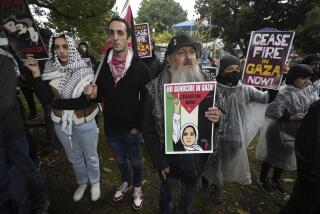Focus on Unaffiliated : Rosh Hashanah for Beginners
Students of Rabbi Daniel Epstein’s crash course in Hebrew are cramming for their first major test.
The students--including children, lawyers and computer specialists--have learned Hebrew phonetics and the meanings of religious phrases. They have been taught that apples and honey symbolize the sweetness of a new year. Some have even tried to blow the shofar, a wind instrument made from a ram’s horn that signifies spiritual awakening during the High Holy Days.
On Saturday and Sunday mornings, these students at the Beth Jacob Congregation-Irvine will have a chance to show what they know at Rosh Hashanah services for beginners, an unusual service catering to county’s unaffiliated Jews--those who do not belong to a temple.
With the approach of Rosh Hashanah--the Jewish New Year, which begins Friday and concludes Sunday, Oct. 8 with Yom Kippur, the Day of Atonement--more congregations across the county and the nation are offering such “crash courses” in Hebrew and Jewish history to help strengthen the connection between Jews and their religion.
Jewish leaders, concerned about the dilution of Jewish heritage and religious observances in America, are also
sponsoring High Holy Day services for beginners: accessible, easy-to-follow holiday celebrations for Jews unaccustomed to those rituals.
The High Holy Days appear to provide a special opportunity.
According to a spokesman for the Jewish Federation of Orange County, there are so many normally non-observant Jews who attend Rosh Hashanah services that many temples need to move services to theaters or hotels. It is a time of year when unaffiliated Jews often consider whether to join a particular synagogue.
Such services and courses catering specifically to unaffiliated Jews are “really catching on across the country” said Rabbi Epstein, who leads a modern Orthodox congregation of 125 families.
‘Alarming’ Assimilation
The national outreach movement, operated by the New York-based National Jewish Outreach Program, aims to stem what he called an “alarming” trend of attrition and assimilation among Jews.
In Orange County, Epstein said, just 10% of an estimated 100,000 Jews are affiliated with a synagogue, and “the attrition rate is spiraling.”
According to the Jewish Federation of Los Angeles, 30% to 40% of Jews marry non-Jews in the greater Los Angeles area. In outlying areas, that rate rises to 60%.
The beginner service and outreach program are part of the worldwide Baal Teshuvah movement, which aims to return Jews to their roots and to observance of traditional rituals. So far, it has swept tens of thousands of Jews in Israel--where most Israelis are not religious--and in major Jewish centers in the United States, Epstein said.
Orthodox rabbis view the attrition rate as a major problem and increasingly feel the urgency to turn the tide, Epstein said.
“What’s at stake is the continuity of the Jewish people,” said Rabbi David Elliezrie of the North Orange County Chabad Center, a strict branch of Orthodox Judaism.
Symposium on Traditions
The center also offers crash courses in Hebrew. On Wednesday, the center will hold a symposium to introduce and explain the traditions of the High Holy Days “so people won’t have the what-page-are-we-on-in-the-prayer-book-blues,” Elliezrie said.
In addition to providing such courses before major Jewish holidays, the Beth Jacob congregation has started outreach programs such as the Sabbath youth program “Turn Friday Night Into Shabbos,” through the National Conference of Synagogue Youth. The programs include parties and weekend seminars where Jewish identity and Judaism are subjects of discussion and debate.
To attract novice worshipers to Rosh Hashanah services, Epstein posted and sent thousands of flyers to attract those who may have fallen away.
“At last,” the flyer says, “a High Holiday service for the novice worshiper.”
Details of Flyer
It goes on:
“* Prayers and Rituals Explained.
“* Biblical Insights.
“* Historical Overviews.
“* Over 200 Shofar Blasts.
“* Questions and Answers.”
“The image a lot of people have of Rosh Hashanah and Yom Kippur is the coming to shul (temple) and sitting, listening and observing through a long service,” Epstein said.
The beginner service is participatory, informal and “anxiety-free,” he said.
The High Holy Days are an appropriate time to start the beginners’ services, Epstein said, because “that’s the time for teshuvah, repentance.
“On the one hand, it’s a chance for us to fulfill our obligation to reach out and care for our fellow Jews. If we don’t reach out to other Jews and give them the opportunity to experience and confront their Judaism, then we are deficient in our religious observance.”
Crash Course Is Free
The crash course is free, he said, and the cost for the service has not yet been determined. Information on crash courses available at several Southland locations may be obtained by calling (800) 44-HEBREW.
One student said she is particularly looking forward to this year’s Rosh Hashanah service. Julie Greenfield, 38, a bank attorney in Irvine, said she has been returning to traditional values since her divorce two years ago. The class provided her with her first instruction in Hebrew.
“I can’t say I’m an expert on Hebrew, don’t forget this was a crash course,” Greenfield said.
“But there’s a feeling when you are Jewish and the tradition goes back thousands of years. It’s a sense of belonging, a sense of family. It’s roots, heritage and a very wonderful experience.”
THE JEWISH HIGH HOLY DAYS
ROSH HASHANA (New Year)
Begins at 5:39 p.m. Friday.
Ten days of penitence begin on Rosh Hashana and end on Yom Kippur.
Some Jews celebrate one Day of Judgment for all mankind; others celebrate two, both marked by prayer in the synagogue.
A ram’s horn is sounded to commemorate these days of remembrance and to acknowledge God’s sovereignty and call for a spiritual reawakening.
According to custom, many recite prayers seeking forgiveness at a river or the ocean to symbolically cast their sins away in a spirit of renewal.
Bread and apples are dipped in honey and prayers are recited for a good and “sweet” year ahead.
YOM KIPPUR (Day of Atonement)
Begins at 5:08 p.m. Sunday, Oct. 8, ends at sundown Monday, Oct. 9,
The holiest, most solemn day of the Jewish calendar. Work, eating, drinking, washing and other activities are prohibited.
Sins are confessed and reconciliation with God is celebrated.
The Kol Nidre prayer before the service on Yom Kippur eve involves a haunting, centuries-old melody; the prayer is a legal formula intended to absolve Jews who fail to fulfill solemn vows and to protect them if they accidentally violate a vow’s specific requirement.
The ram’s horn, or shofar, is sounded at the closing of the concluding service.
A festive meal ends a daylong fast.
More to Read
Sign up for Essential California
The most important California stories and recommendations in your inbox every morning.
You may occasionally receive promotional content from the Los Angeles Times.









